The Intel Xeon W-3175X Review: 28 Unlocked Cores, $2999
by Ian Cutress on January 30, 2019 9:00 AM ESTCPU Performance: Rendering Tests
Rendering is often a key target for processor workloads, lending itself to a professional environment. It comes in different formats as well, from 3D rendering through rasterization, such as games, or by ray tracing, and invokes the ability of the software to manage meshes, textures, collisions, aliasing, physics (in animations), and discarding unnecessary work. Most renderers offer CPU code paths, while a few use GPUs and select environments use FPGAs or dedicated ASICs. For big studios however, CPUs are still the hardware of choice.
All of our benchmark results can also be found in our benchmark engine, Bench.
For our graphs, some of them have two values: a regular value in orange, and one in red called 'Intel Spec'. ASUS offers the option to 'open up' the power and current limits of the chip, so the CPU is still running at the same frequency but is not throttled. Despite Intel saying that they recommend 'Intel Spec', the system they sent to us to test was actually set up with the power limits opened up, and the results they provided for us to compare to internally also correlated with that setting. As a result, we're providing both sets results for our CPU tests.
Corona 1.3: Performance Render
An advanced performance based renderer for software such as 3ds Max and Cinema 4D, the Corona benchmark renders a generated scene as a standard under its 1.3 software version. Normally the GUI implementation of the benchmark shows the scene being built, and allows the user to upload the result as a ‘time to complete’.
We got in contact with the developer who gave us a command line version of the benchmark that does a direct output of results. Rather than reporting time, we report the average number of rays per second across six runs, as the performance scaling of a result per unit time is typically visually easier to understand.
The Corona benchmark website can be found at https://corona-renderer.com/benchmark
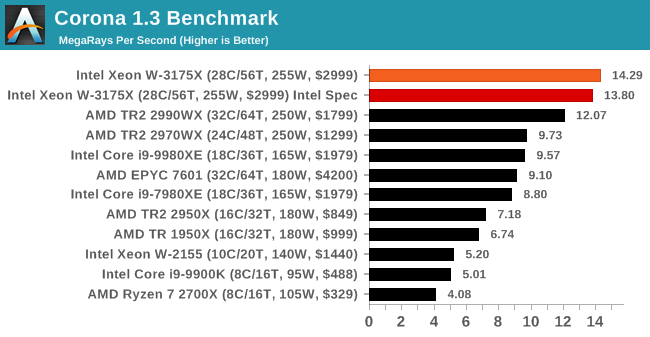
.
Blender 2.79b: 3D Creation Suite
A high profile rendering tool, Blender is open-source allowing for massive amounts of configurability, and is used by a number of high-profile animation studios worldwide. The organization recently released a Blender benchmark package, a couple of weeks after we had narrowed our Blender test for our new suite, however their test can take over an hour. For our results, we run one of the sub-tests in that suite through the command line - a standard ‘bmw27’ scene in CPU only mode, and measure the time to complete the render.
Blender can be downloaded at https://www.blender.org/download/
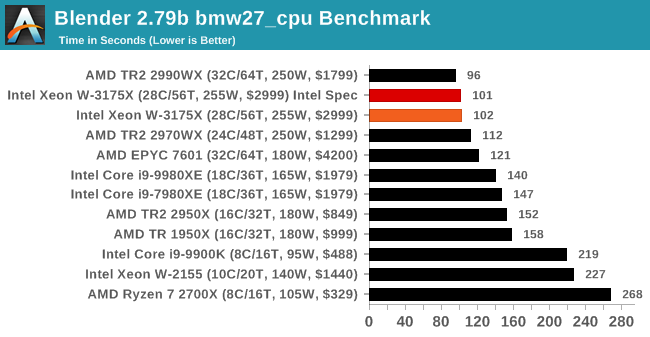
.
LuxMark v3.1: LuxRender via Different Code Paths
As stated at the top, there are many different ways to process rendering data: CPU, GPU, Accelerator, and others. On top of that, there are many frameworks and APIs in which to program, depending on how the software will be used. LuxMark, a benchmark developed using the LuxRender engine, offers several different scenes and APIs.
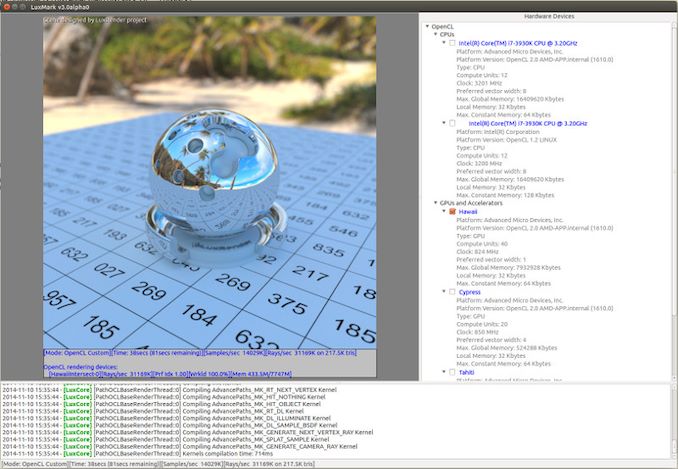
Taken from the Linux Version of LuxMark
In our test, we run the simple ‘Ball’ scene on both the C++ and OpenCL code paths, but in CPU mode. This scene starts with a rough render and slowly improves the quality over two minutes, giving a final result in what is essentially an average ‘kilorays per second’.
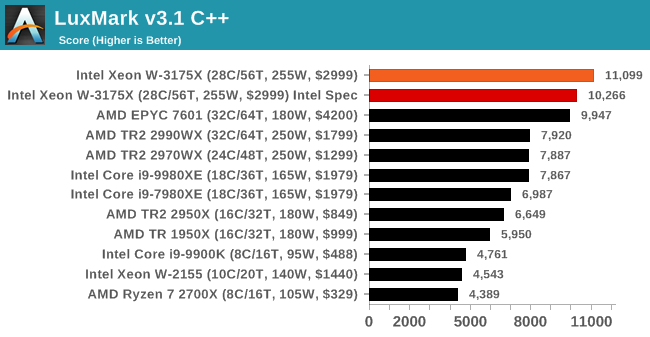
.
POV-Ray 3.7.1: Ray Tracing
The Persistence of Vision ray tracing engine is another well-known benchmarking tool, which was in a state of relative hibernation until AMD released its Zen processors, to which suddenly both Intel and AMD were submitting code to the main branch of the open source project. For our test, we use the built-in benchmark for all-cores, called from the command line.
POV-Ray can be downloaded from http://www.povray.org/
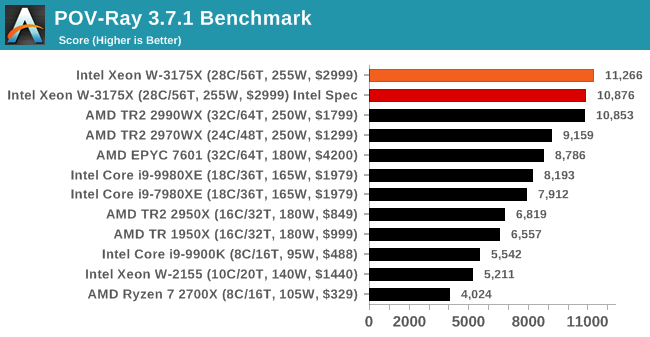
.











136 Comments
View All Comments
eva02langley - Thursday, January 31, 2019 - link
Forget to mention Omnium Gatherum - The Burning ColdPeachNCream - Thursday, January 31, 2019 - link
"On the power side of the equation, again the W-3175X comes in like a wrecking ball, and this baby is on fire."It's more like a Miley Cyrus licking a sledgehammer thing to me.
sgeocla - Wednesday, January 30, 2019 - link
Computex 2018: Intel 28 core 5 Ghz out by end of year.February 2019: Intel 28 core 4.5 Ghz, costs 70% more than competing product.
Intel is early on promises and late on delivery as always.
BigMamaInHouse - Wednesday, January 30, 2019 - link
The CPU is 3000$ + 1500$ MB+ ECC + eXtreme case/PSU/AIO.Thanks Ian Cutress for the honest review!
(unlike "JustBuyIt that gave this fail product(Total System) 4.5/5 rating vs 2990WX 3.5/5 because its expensive!")
Morawka - Wednesday, January 30, 2019 - link
oh wow, i didn't realize the Dominus Extreme was so expensive.tamalero - Wednesday, January 30, 2019 - link
We're getting a ton of "sponsored" BS articles lately that are cynical.eva02langley - Thursday, January 31, 2019 - link
WCCFtech gave the MSI 2080 TI lightning 1600$ GPU a 10/10 for value...FMinus - Friday, February 1, 2019 - link
RX 570 is 10/10 along with maybe the GTX 1060, everything else is going down the value ladder pretty fast from that point on. For any consumer/gaming oriented GPU that passes the $500 mark I'd give it -1/10 value score.DanNeely - Wednesday, January 30, 2019 - link
The on stage demo was using a chilled water setup, that they managed to push that system higher than Ian could with room temperature water is only to be expected.jardows2 - Wednesday, January 30, 2019 - link
This seems like a really good processor for a productivity station. I think, especially at the expected price, it would sell really well. That has me puzzled then as to why Intel would have such a limited run. The supposed figures is barely enough to send to review sites around the world, let alone have a profitable product line. If they produced 10X the amount of these, they'd probably sell them all. Why is Intel leaving easy money on the table? Something doesn't seem right about this picture.